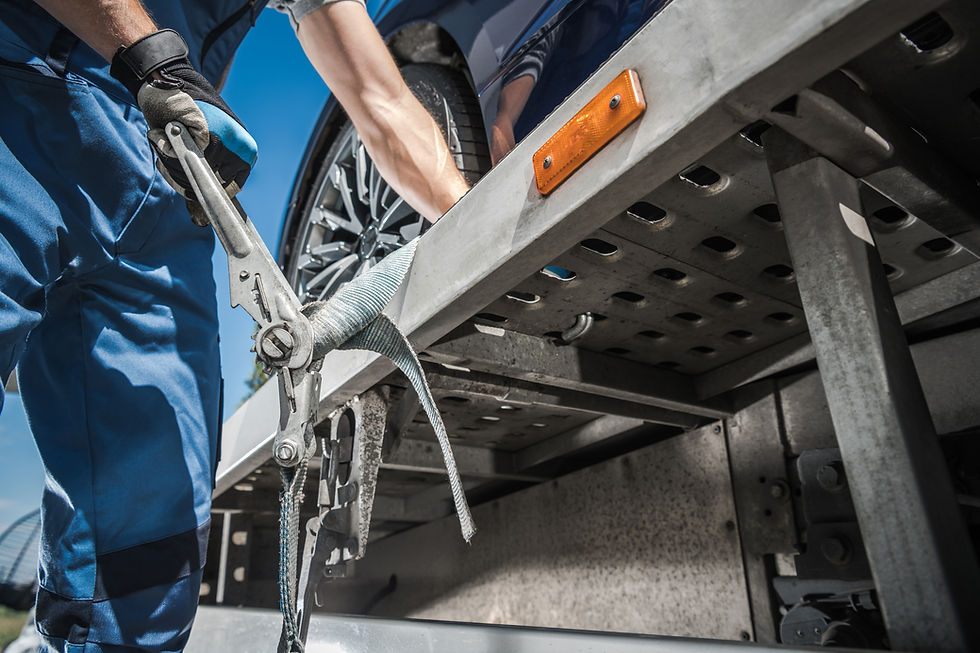Understanding Towing Options: A Guide for Consumers—Flatbed, Towing, and Wheel Lift Towing
- Larry Rodriguez
- Jul 24
- 3 min read

If you've ever found yourself in a situation where your vehicle needs to be towed—whether due to a breakdown, flat tire, or accident—you might wonder what type of towing service is best suited for your car. Not all towing methods are the same, and the choice can impact both the safety of your vehicle and the cost of the service. Let’s explore the main types of towing: flatbed, traditional towing, and wheel lift towing, along with their differences, costs, and considerations for specialized vehicles like all-wheel-drive (AWD) and four-wheel-drive (4WD).
Types of Towing Services
Flatbed Towing
What It Is:
A flatbed tow truck features a large, flat platform that the entire vehicle is driven onto or lifted onto for transport. The vehicle sits securely on the truck's bed, with all four tires off the ground.
Pros:
- Safest option for most vehicles: No parts of the vehicle are left on the ground.
- Ideal for AWD/4WD vehicles: Prevents drivetrain damage since all wheels are lifted.
- Suitable for damaged or immobile vehicles.
- Less risk of additional damage during transport.
Cons:
- Generally more expensive than other towing options.
- Less accessible in tight spaces due to the size of the flatbed.
---
Traditional Towing (Hook-and-Chain or Belt Towing)
What It Is:
This older method involves attaching a hook or chain to the vehicle's bumper or frame. The vehicle is pulled from the front or rear on a two-wheeled dolly or with a sling.
Pros:
- Typically less expensive.
- Suitable for short distances or emergency roadside assistance.
Cons:
- Can cause damage to the vehicle’s bumpers or undercarriage if not done carefully.
- Not ideal for delicate or damaged vehicles.
- Not recommended for AWD/4WD cars or vehicles with flat tires.
---
Wheel Lift Towing
What It Is:
A wheel lift tow truck uses a metal yoke or boom to lift the front or rear wheels off the ground, usually by placing it under the tires. The remaining wheels stay on the ground.
Pros:
- Less damaging than traditional hook-and-chain towing.
- Safer for most vehicles.
Cons:
- Still lifts only one end or side of the vehicle, which can be problematic for AWD/4WD systems.
- Not suitable for all types of vehicles or flat tires.
Cost Considerations
The cost of towing varies depending on the distance, vehicle type, and towing method:
| Towing Method | Average Cost (within 5-10 miles) | Additional Costs |
|----------------------------|----------------------------------------|--------------------------------------------------|
| Flatbed Towing | $95 - $145 | Higher for longer distances or remote locations |
| Traditional Tow (Hook/Belt)| $85 - $185 | May incur damage repair costs if inappropriate |
| Wheel Lift Towing | $80 - $195 | Similar variations as above |
Special considerations for AWD/4WD and flat tires:
- AWD/4WD Vehicles: Require careful handling. Flatbeds are strongly recommended to prevent drivetrain damage. Using a wheel lift or traditional towing can cause costly repairs if the vehicle’s system is affected.
- Flat Tires: If you have a flat tire, some towing services can change the tire on-site, avoiding the need for towing altogether. Alternatively, a flatbed ensures no additional damage and can transport the vehicle safely without driving it.
How to Choose the Right Towing Service
- For AWD/4WD Vehicles: Always opt for a flatbed tow. This prevents unnecessary stress on the drivetrain and minimizes the risk of damage.
- For Damaged Vehicles or Cars with Flat Tires: A flatbed is generally the safest choice.
- For Short, Emergency Tows: Traditional or wheel lift towing may be sufficient if the vehicle is operational and undamaged.
- Cost vs. Safety: While flatbeds are more expensive upfront, they often prevent costly repairs caused by improper towing methods
- Ask About the Method: When calling a towing company, specify your vehicle type and situation to ensure the appropriate method is used.



Comentários